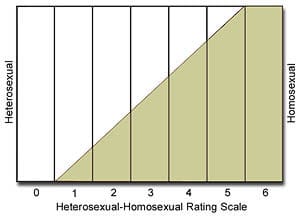Sexual Identity
This month’s column I have decided to talk about sexual identity. I am regularly asked various questions by both women and men about whether they may be gay or lesbian or bisexual based on a same-sex experience. As you will read, it is not so clear when it comes to defining sexuality.
I have a male friend who identifies as straight, is attracted to women, and is comfortable having sex with both women and men. His girlfriend enjoys threesomes with two men and he does not see that if he engages in sex play with another man that he is anything other than straight (heterosexual).A client once reported feeling confused about his sexuality. He had a girlfriend and enjoyed sex with her, but when alone he also enjoyed men watching him masturbate on cam. He thought he might be bisexual. We explored sexuality through the sexual trichotomy and we concluded he was straight. Although he liked men watching him masturbate on cam, he had no interest or desire of actually doing this “live” in front of a man, or participate in sex play with a man.
I recently received an email from a young woman (19) who had a threesome with her boyfriend and another woman. She too thought she might have been lesbian or bisexual. I responded that this sexual act alone (even if repeated) did not need to challenge how she identifies; that she needed to consider all aspects of her sexuality, not just who she had sex with.
A couple came to me for therapy. The wife had discovered her husband had been watching gay porn on his computer. She wanted to know if that made him gay and if he might really be bisexual. Through therapy we explored his identity and although he liked the idea of having sex with another man, realised he could not have sex outside of his relationship. He was happy with watching porn. The outcome was husband and wife began watching bisexual (MMF/MFM) porn together.
So How Can These People Be Straight (Heterosexual)?
Kinsey developed a scale to understand human sexuality. Through his research Kinsey realised people did not fall in to discrete categories and there were more than two categories of sexuality (straight/gay), even more than three categories of sexuality (straight/bisexual/gay).
Kinsey identified seven categories.
0 = Exclusively heterosexual with no homosexual activity
1 = Predominantly heterosexual, only incidentally homosexual activity
2 = Predominantly heterosexual, but more than incidentally homosexual activity
3 = Equally heterosexual and homosexual activity
4 = Predominantly homosexual, but more than incidentally heterosexual
5 = Predominantly homosexual, only incidentally heterosexual
6 = Exclusively homosexual with no heterosexual activity
Being gay, lesbian or bisexual is not easily defined, as you have just read above. Many people think a person’s sexual identity is defined by who they have sex with – It is not that simple. Nor is it easy to fit a sexual identity into a discrete category.
Alfred Kinsey, a famous sex researcher from the 1940s onwards, described sexuality on a seven-point scale from exclusively heterosexual to exclusively homosexual. Kinsey recognised the variety in the expression of human sexuality based on his interviews with people about sexual behaviour. This study developed ‘The Kinsey Scale’.
Another way to think about sexual identity is to use the Sexual Trichitomy developed by Deb Ollis and colleagues at the Australian Research Centre in Sex, Health and Society in Melbourne. They suggested that a person’s sexual identity contains three aspects:
- Identity – how the person identities. This can be broken down into public identity and private identity. Someone may publicly identify as straight and privately identify as bisexual.
- Attraction – who the person is attracted to. Men, women, or both.
- Behaviour – who the person has sex with.
For many people there is an alignment between the identity-attraction-behaviour trichotomy. It is also possible for someone to identify as heterosexual (straight), be attracted to the opposite sex and have sex with people of both genders. When we consider these aspects we can accommodate a greater variety in sexuality and its expression. As you read above.
So as you can see defining one’s sexuality is not straight (no pun intended) forward.
We can then add another aspect to make it even more confusing – Fantasy. Who we fantasise about having sex with, and I include the type of porn watched as well under fantasy. Fantasy is not real. Porn is not real it is a fantasy. I mention fantasy and porn because people often ask me if because they fantasise about sex with someone the same gender as them, or watch porn of same-sex activity, does that make gay or lesbian or bisexual. The answer in short in no. I also talk to them about how they identify, who they are attracted to and who they have sex with.
Am I Gay (or Lesbian or Bisexual?
My answer: It depends on many factors.
The expression of human sexuality is varied. It is not always possible to sit comfortably in the categories of straight, gay or bisexual. Being straight/gay or bi is not simply defined by who you have sex with. We also need to factor in how someone identifies and who they are attracted to.
If you have concerns about your sexuality and identity see a sex therapist in your local area who will be able to work with you about the issue. It is important people have a healthy sex life, and a healthy sex life is one without anxiety about sexuality.
Remember a healthy life includes a healthy sex life.
Enjoy!
Dr Christopher
Dr Christopher Fox is a Psychosexual and Relationship Therapist at Sex Life Therapy in Melbourne. He has clinics in East Melbourne and Frankston
Disclaimer: The information contained in this document should be read as general in nature and is only to provide an overview of the subject matter covered. Please read product packaging carefully and follow all instructions.



